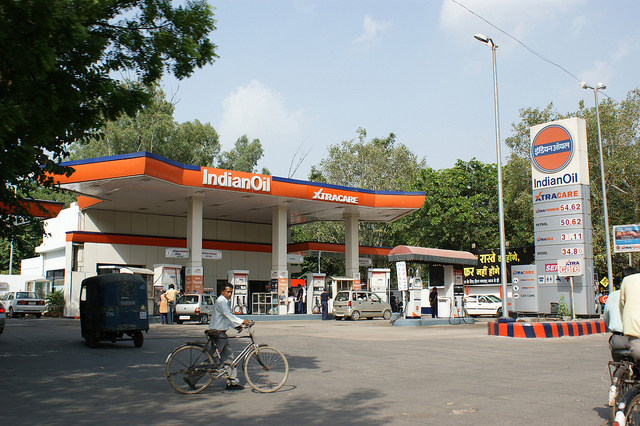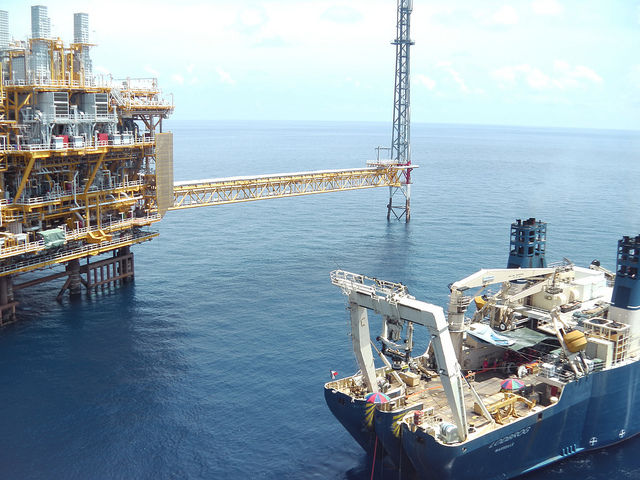Dr Duncan Clarke is the founder, Chairman and CEO of Global Pacific & Partners, a leading private advisory firm in worldwide petroleum with 30 years in global oil and gas. Dr Duncan Clarke has acted as advisor to numerous companies and governments in Africa, Asia, Latin America, Middle East, Europe and North America.
The Columnist had a chance to speak to Dr Clarke in person, at the 19th Asia Upstream Conference and 22nd Asia Petroleum Strategy Briefing, on his thoughts on the development of Asia’s Oil & Gas industry.
(This interview was conducted as a follow-up to our Issue #15 on Oil and Gas.)
The Columnist (TC): You mentioned in an earlier interview with International Resource Journal that you wrote a report on Southeast Asian oil industry in the early 1980s. Tell us, how has the industry in Southeast Asia evolved over the years?
Duncan Clarke (DC): Well, significantly. Back in the early 80s, there were fewer players and Southeast Asia was the place to be. Asia lost a little bit of its edge as Latin America opened up, with the privatisation from Argentina to eventually the opening up of Brazil and Venezuela, as many companies flowed into those markets and lightened the portfolio in Asia. In the 90s, Latin America was a big target, and subsequently, Africa. Now, it’s more balanced across the world.
In Southeast Asia, or Asia at large, is that on one hand, there are more larger independent companies, and countries who are trying to entice capital and companies in, to offers of acreage and opportunities. The paradox on the other, is that Asian national oil companies have invested more in the region, and even more so in the rest of the world, primarily for energy, equity oil, equity gas and supply lines. Those are some of the big paradigm changes that I did find.
Another evolution is that more countries in Asia now have opportunities. It was not easy (to break into the Asian markets). In fact, it was impossible in the past to get into onshore China; Myanmar was locked up for many years despite an earlier opening in 1989 for a brief period. Now, we have new smaller countries entering the market, such as Sri Lanka, Fiji and Papau New Guinea. Even India, which was quite a closed environment in the 80s due to state control, has opened up. So the market is now much more competitive and open in Asia.
TC: Compared to US and European counterparts, do you agree that Asian players are trailing behind in terms of innovation and R&D capabilities in the Oil & Gas industry?
DC: The big investors in R&D were traditionally the super majors (e.g. ExxonMobil, BP, Shell, Chevron). They in turn subcontracted some of their oilfield requirements to specialists, such as Schlumberger and Petrofac, who can do it more efficiently and integrate the whole system. This continues to be the case. At the same time, these specialist companies are investing in R&D and technologies themselves, so they are bringing alliances into the package.
Of course, it costs money to do R&D. This is upfront capital and it’s never certain that innovation can succeed. Nevertheless, out of all the innovation cycles, you do get some very important component, such as back-in-time 3D seismic, and technologies to enhance oil production, reservoir management and software development. All of these are coming to the fore, and being applied in unconventionals as well.
It doesn’t mean that these innovations can’t come out of Asia; it just means that somebody has to put up the risk and capital to do it. And it won’t be led by governments, it has to come from the private sector; because governments have other commitments on their hands, such as social education and health. Given the demographic involved in Asia, the primary responsibility of these governments will be geared more towards these commitments.
Having said that, the bulk of R&D is not only from Europe and America, but also from Japan and Korea. You can’t easily put against Korea and Japan, smaller countries (like Philippines and Brunei), who don’t have the scale to develop as far, but you do notice that these countries are coming forward with developments too.
TC: If innovation has to be led by the private sector, then would Asian state-owned oil companies be less inclined to innovate due to national interests and agenda?
DC: Well, state-owned companies still do innovate. There are large training and R&D facilities in India and Malaysia, and China. For example, Petronas (Malaysia) has set up a whole programme on innovation.
TC: Do you think that organisational behaviour plays a role behind Asia’s innovation and R&D lag behind its Western counterparts?
DC: I just don’t see the world of ideas and innovation somehow bound inevitably to one cultural dimension or to a typical organisation. Ideas, innovation and technologies tend to go global very quickly. Hence, while many of these technologies may be proprietary for the short term, they become off-the-shelf after time. Furthermore, technologies are modified and adapted to local circumstances, so it is not the case that innovation in the oil and gas industry is specific to any region or country.
TC: So you do believe it’s possible for an Asian company to come up with the next big thing in the industry?
DC: Well, they already have. There are several Asian companies who are leaders in this arena, and on the edge of new developments. Keppel is a good example of a first-class company from Singapore. In addition, you’ve got companies in Japan that are working on gas hydrates.

With the opening of markets such as India, there are more opportunities now in Asia as compared to the 1980s-90s. Photo: IFPRI-IMAGES, Flickr.
TC: Hydraulic fracturing, or fracking as commonly known, is not a recent innovation.However, refinement and incremental innovation in fracking techniques has lengthened the life of oil fields and increased the world’s pool of reserves. Given that US had a head start in this, do you see any issue for Asian players to simply adopt the technology without first researching to see how they can achieve greater innovation?
DC: The story of fracking is a forty or fifty-year history, particularly in North America where they have applied it successfully and test-run their reserves, both for unconventional gas and title oil. Eventually, it spread to Australia and it’s coming into China and India. Shale gas and title shale oil will become bigger in Asia. This technology is well-known, so there is no need to “reinvent” the “wheel”, you just take the “wheel” and put it on your machine and make it work.
As for developments in Asia, China has plenty of shale gas and they are only beginning to look at it now. Indonesia has coal beds, methane and a whole range of unconventionals, so we’ll see more of that in Asia’s energy mix in the long term future. The energy demand is great, primarily of the back of economic growth which will continue, right across the board. Given that Asia’s very long on gas – with very substantial reserves and supplies – I think the process (of innovation in Asia) will happen in time to come.
TC: What’s your opinion of Indonesia’s recent jumpstart into fracking, ahead of its neighbours? Should other Southeast Asian countries follow suit?
DC: I think so, because everyone is looking for additional supply of domestic resources, as opposed to import dependence, where you end up being a prisoner of the markets (crude prices are quite high, over hundred dollars per barrel).
Indonesia has got a competitive advantage, due to its extensive hydrocarbon and energy domain, stretching from Sumatra right to West Papau. It has a huge coal base and large unconventional opportunities. China will also get into fracking as quickly as it can. However, many of the issues barring entry lies not in the technology, but due to above-the-ground permitting, leasing, licensing and of course, capital to support it.
TC: From what we understand, shale gas exploration (fracking) is more costly than the conventional methods?
DC: Not necessarily, if not it wouldn’t happen so successfully in the United States. It can be done efficiently with managed risks and environmental protection. But you do need companies who have got the skills and technology, and are able to invest accordingly so as to meet the governmental requirements. Shale gas exploration will develop increasingly in Asia.
TC: Fracking has taken the US by storm, and aside from the environmental concerns, fracking has caused oil prices to substantially lower. Do you think this has made prospecting and production for Southeast Asian countries any less lucrative?
DC: No, I don’t think so for now. In fact Asia would probably be a net beneficiary of this (phenomenon), because some of the unconventionals and gas in North America – particularly Canada, with the development of energy exports of Kitimat and the flow of gas supply into Asia – would help to soften the energy and gas prices in this region.
As gas tends to be regionally specific, whatever happens in North Africa and Southern America won’t directly impact other regions in the short term. However, this can have an effect in the long term. For example, big discoveries of gas in the east coast of Africa (Mozambique, Tanzania) will start to flow to Asia in a period of 8 years. That’s why Asian state companies have bought into Mozambique, such as ONGC from India, CNPC from China, PPTEP from Thailand; because they are looking to get equity and security of supply for the contract and outflow of gas into Asian markets, where they are gas users and import-dependent parties. There will be a new paradigm of mixes and flows.
TC: It’s interesting that you mentioned that the issue of security, as we learnt in another report (Oct 2012 report published by Chatnam House on “What Next for the Oil & Gas Industry?”) that the question of oil security has shifted to Asia, as Asia is becoming bigger importers of oil.
DC: Yes, particularly China, India. Even Indonesia is in a similar position, also because of its declining in crude oil production from over the last several years, on net terms since 2003 or 2004. They’ve got a lot of more resources but they could do better at home. They have difficulty turning it around, although they have a lot of ideas on how to do that.
You’re never going to get away from the need for oil, even if you have an increase in gas, because it’s a key element in transport fuels and a range of other uses. That would give a sense of opportunity and discovery in Asia at the same time, as there’s a lot of acreage and opportunities unexplored yet in deepwaters and frontier zones, and new countries coming to market. However, Asia as a whole is a crude (oil) importer, and it looks like this is likely to continue.
TC: Given that Asia now holds the key to this question of security, any disruptions to Asian supplies will affect the world oil price by quite a bit?
DC: It will. Asian net import demand is an increasing share of the marginal barrel, of additional world oil demand growth. And it’s slightly softer now, because of the economies have weakened a little

There remains unexplored opportunities in deepwater drilling for Asia. Photo: Alcatel-Lucent, Flickr.
TC: How can Asian Oil & Gas companies play a part in steering the direction of the industry?
DC: I don’t think any particular country can steer the industry. The industry is a global phenomenon; it responds to prices, to allocation of capital and the portfolio of companies, to the opportunities set by the terms and conditions of contracts in different parts of the world and regions. And even within a region, if terms are too tough, for example in Indonesia, people will shift the assets slightly to somewhere else.
In the long term, (any change in the direction) is going to need many Asian countries who have strong contractual terms and high government take-up, to provide more incentives for companies to stay, invest more or to attract new companies. That’s a worldwide thing, you find that anywhere and everywhere. That’s how I see it going in the future.
This interview was conducted for The Columnist, a newsletter by Consulus that offers ideas on business, design and world affairs. The views expressed in this article are those of the interviewee and do not necessarily reflect the views of Consulus.




